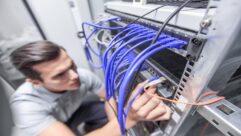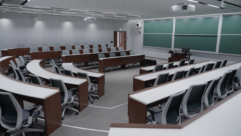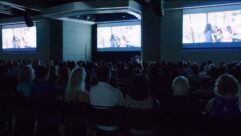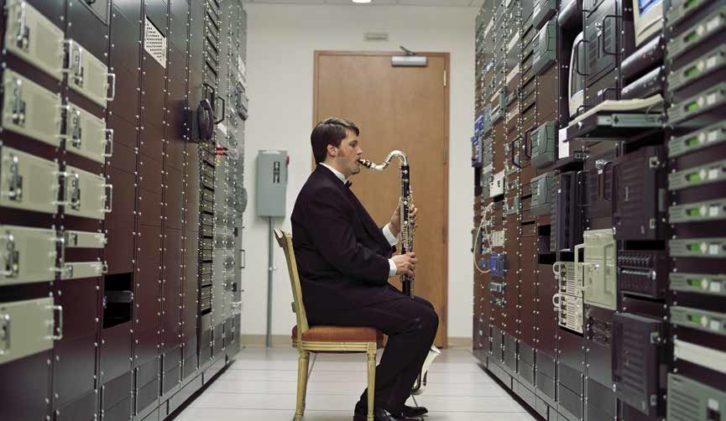
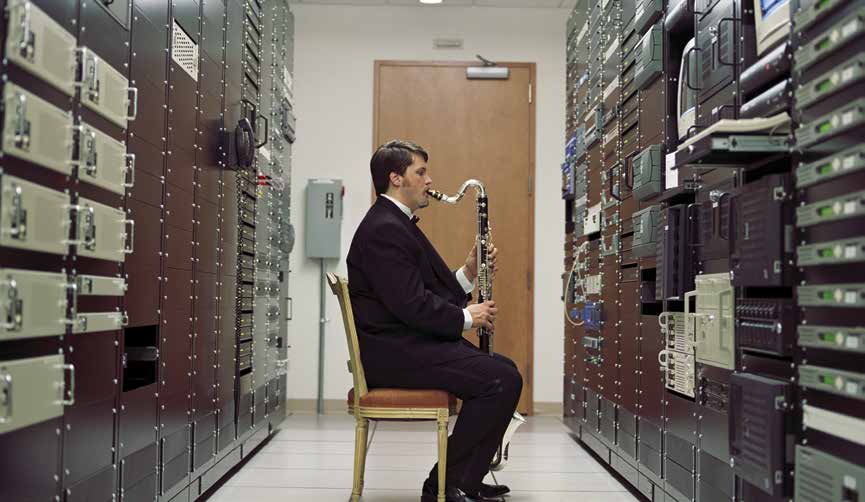
Audinate co-founder and CTO Aidan Williams is thinking back to a point in time when nothing was certain. He laughs as he remembers, but there’s something in the way he says “five, six years at the beginning”—it still has a visceral edge.
“Networking technologies are really only useful if you can talk to someone else with them,” he says. “Imagine you’re Bell and you invented the first telephone and you’re trying to sell it, but there’s no one to call. So the ‘getting started’ bit is very hard, very hard to sell the first customer, and the second, and the third, but eventually you get to the point where enough people have it that you can call most of your friends.”
But, that’s not enough, he reminds me. What if it turns out you’re building Google+ and not Facebook and everybody’s on Facebook? In retrospect things seem less perilous and more inevitable, but think about it: Williams couldn’t know then what we know now.
Wherever there is a history of Dante there is Bruce Jackson, the Australian audio engineer who died in a 2011 plane crash midway through a storied career. He founded Jands, mixed for Elvis, Bruce, Fleetwood Mac, Lou Reed, etc, etc, and is universally acknowledged for his role on the Sydney Olympics and his pioneering work with Clair Brothers, Apogee, and—significantly for Dante—Lake Technology. Jackson saw the potential of this new networking technology and in 2008 the iconic Dolby Lake processor became the first Dante-enabled product. Dante’s run in live sound began on a Barbra Streisand tour.
When I ask Williams about milestones for installed sound, he immediately goes to the relationship with Yamaha. This collaboration bridged between live and installed sound and gave Dante an introduction and credibility within the industry that’s hard to overstate. “At the time, we were still at the stage where everything was endless conversations,” Williams recalls. “It was: how could it possibly work? How does it work? Show me a demo.”
That all changed in early 2012 when Yamaha invested $5 million in expansion capital and soon after came out with their first products with Dante built in, significantly the CL mixer. “When the CL came out, literally within three months we stopped being asked for tire-kicking demos and constant proof that Dante worked,” Williams says.
The relationship had started six years prior. “They were a conservative, quality-conscious company for us to work with,” Williams says of Yamaha. The exchange of knowledge seemed like an opportunity. “We were at the point where we were looking for the next generation of digital audio networking,” Yamaha Director of Marketing Marc Lopez recalls of that time.
“We had actually started looking at some of our own internal solutions for Cat5-based networks, but we felt we wanted to utilize something that was more of an open standard. And not something that had happened overnight. When we first integrated CobraNet we were not an early adopter, we were supporting what was already commonly being used. We had been keeping an eye on the market for what’s next. We saw Dante pop up on a few manufacturers products.” (Some of Audinate’s early OEM partners had been, in addition to Dolby, Lab.gruppen, Bosch, and Peavey; Bruce Jackson had used Dante to network 160 Lab.gruppen amps on the opening and closing ceremonies for the 2010 Summer Olympics…because Dolby had sold Lake to Lab.gruppen).
“We were interested in Dante because it was very IP-friendly, very flexible, and used standard networking equipment; Yamaha doesn’t like to bring more network protocols to the table if we don’t have to,” Lopez continues. “I can still recall that moment when we decided to move in this direction with Audinate and start with the MY expansion card. That was its audition and it did…extremely well.”
“It was produced relatively quickly,” Lopez says, “and we found that was our gateway to Dante for several years.”
The two companies found a comfort level with the technologies and relationship. Meanwhile other companies including Allen & Heath, Midas, Symetrix, Shure, and DiGiCo came on board between 2009 and 2011. The first fully integrated Dante product—Yamaha’s CL digital mixer series (along with the RIO stage boxes) made a game-changing statement at the trade shows in the first half of 2012. Yamaha had built it in.
“When we integrated Dante into the CL that type of monitoring and control was unique,” Lopez recalls. “Everyone else relied on Dante Controller, and that’s how they wanted it to work, with a birds’ eye view. We wanted to make Dante more accessible to live sound users who maybe didn’t have an extra monitoring laptop and keep it more in the workflow of a standard mixing console.”
What had started as a card slot and point-to-point thing, began to grow in cohesiveness and interoperability, Lopez says, as networks expanded to encompass more endpoints, processes, and interfaces.
“The networking story with our switches (SWP1) is deeply tied to Dante,” Lopez points out. “We might never have brought that product outside of Japan, if it was not for needing a well-designed switch for professional audio applications that was easy to set up.” That’s an example, he says, of how a product can deploy outside its original intention in response to a market need and opportunity. Networking is both.
But Dante didn’t just shift the market for products, it also created opportunity for shifting alliances and collaborations, such as those that Shure and Yamaha are pursuing with this year’s integration between the ULXD wireless systems and the CL/QL consoles.
“We’re told that Yamaha put Dante on the map,” Lopez concludes. “Really, we found it a very exciting technology that we felt would be very beneficial to our customers and implemented it to its full extent. We’re continuing to do so, depending on our objectives for a given product.”
“The Yamaha connection was a big deal,” Williams recalls, “it started to stimulate some interest.” Within the next year the number of OEMs had nearly doubled from 50 to 98, though it would be another two years before many of the resulting products got to market. The ecosystem was growing.
“With live sound, the console is the network centerpiece. Similarly for installed sound, the signal processing sender is a kind of centerpiece.” Williams says. He’s thinking of Symetrix and how founder Dane Butcher was another early partner. Symetrix broke with the traditional DSP crowd with Dante SymNet, a decision that Butcher has said helped cement his company’s role in installed sound.
Throughout this time, Dante installs started to turn up in venues of various sizes and companies like Allen & Heath were doing Dante training on their products. There was criticism from people who didn’t think the industry needed a licensed networking technology, there was activity around standards including AVB, and AES standards. Today it’s not so much looking like there will have to be a winner, but more of a growing sophistication about networking that trends towards interoperability and co-existence.
At the same time, the licensed ecosystem that Audinate provided with Dante helped to bridge Pro Audio and AV into networking in a commercially supported way at a time when that was needed. It helped make people feel safe enough to bet their businesses on networked digital audio.
On the studio side, Focusrite product manager Will Hoult says that starting in 2010, Focusrite began to collaborate with Audinate on a PCIe card that could support 128 channels of IO.
“We made our first announcement of RedNet at NAMM in January 2011. “We needed to get the sample rate capability of Dante up to make it suitable for our customers’ workflow; prior to that it was limited to 48kHz and we needed 192.”
The reason that specification hadn’t come up prior, Hoult says, is at the time most of the products in the small Dante ecosystem only ran at 48kHz. “We had that need from a studio perspective, to offer parity with digital interfaces that were commonly in use and to take what people were doing currently from a workflow perspective and add networking to it.” He says the goal was ease and scalablity. “We’re talking about audio professionals. For a company or product to come along that requires a fundamental step change in workflow—that’s a risk to their livelihood. We were looking to almost replace the existing workflow, but then offer some evolution on top of that. To provide that confidence and certainty that someone’s business won’t be affected.
“On the other hand, I’ve seen the early adopters who really embraced the IP tech early on. What I see with those is they will really push the boundaries of what the network is capable and inventive ways.” Then, Hoult says, as adoption accelerates and people see other companies doing it, the “keeping up with the Joneses’ kicks in.”
“What we were looking at in a facility was how the process of transporting audio from one location to another in real time is going to evolve? When you look at the systems that have been available for decades—analog point-to-point multicore cabling patch bays—it’s kilometers of cables in walls… The cost is substantial and so is the cost of maintenance. That’s a big incentive for change.”
Focusrite brought decades of audio experience to the Audinate collaboration. “We brought that heritage of our pres and analog devices— that flat frequency, wide dynamic range to the networking world,” Hoult recalls. “While Aidan was from telco communications, he’s also a musician and had a lot of synergy for what we’re doing in the recording process—totally transparent audio transport in terms of audio quality; lossless; with high quality AD conversion and mic pre amps.”
From its studio roots, as use cases for RedNet proliferated into commercial AV, Focusrite became another entry point for Dante networks across the AV markets.
Another expansion to the ecosystem was gradually taking place, spreading to Dante-enabled endpoints, as speakers and microphones joined the platform. For example, by 2014 EAW and PreSonus had Dante-enabled speakers, part of a group of now 170 partners. This broadening of the ecosystem, Williams said, also introduced new aspects of innovation. “A good example is Shure,” Williams says. “They have thought about how networking can enable them to make genuinely new products, they’ve thought about what they can really do with high-density wireless.”
“We have a different viewpoint by virtue of coming from the angle of a microphone company,” says Chad Wiggins, Senior Director Networked Audio Systems at Shure. “By that I mean that some of the early adopters networking products were more in the middle of the chain at the system level. We’re an endpoint.
“Shure was one of the first microphone companies to embrace networking in microphone products—not just in terms of getting audio packets to other devices, but enabling control and other things in the microphone to be software-defined. For the past 80 to 90 years, microphones could have incremental improvements, but with networking and software systems, microphones can be innovative.
“The conventional microphone is a one trick pony—it does what it does and not much else,” Wiggins continues. “If it does have some frequency or sensitivity control, the way to change those settings is to go to the microphone and physically throw a switch. With the new capabilities that emerge, the microphones can take on different characteristics, different pickup patterns, different routing or EQ, and can store those things on board. It becomes a little computing platform now with an OS and storage and processor, and some IO for control and such. They can be configured and managed remotely and they’re taking on more intelligent roles.
“Historically our job has been to capture the acoustics, convert it to electric and send it down the line as fast as possible. We can add value to that audio signal and we’re looking at ways of doing that. Maintaining some sort of analytics around quality. Latency. Clock. Reports. Metadata. Even mixing the audio. We have a pretty diverse set of R& D efforts underway and like any company some will bear fruit and some won’t.
“We think there are some things we can do to make the downstream processing do less work. One of my favorite quotes from a customer: ‘I need microphones and I need loudspeakers and I need everything in the middle to be software.’”
He says the work with networking has been “our great opportunity to expand beyond our traditional partners and simultaneously enhance our interoperability with current partners. They’re all innovating in their pieces of the system—it’s one of the great things about the time that we’re in. We’re all settling on common language and ways that we expect to be able to work with each other that goes beyond traditional roles.
Today Shure has a portfolio of Dante-enabled products that grew out of a measured beginning.
“For us around the time that we were starting to adopt Dante, it was a little speculative; there were a handful of licensees. It was available and it worked as advertised and it addressed some things that none of the others did—more user friendly, reliable, gave the users more confidence,” Wiggins explains. The first couple of products that we did were not too reliant on interoperability. As we were in the development we saw Audinate signing on more licensees, more brands had more products, and we expanded our Dante products to include ULXD. That partly benefited from having more third parties.
“Audinate has been a good partner for us and their solution is very good—I don’t just mean technically that it works—all the software drivers, utilities has been good—it’s commercially supported. We also got better support from them for smaller channel counts—-that’s important because we’re not a high-density channel licensee.
Today Audinate has 380 partners and Dante is integrated into more than 1200 products and growing. Over the past ten years, that growth has fanned out across the ecosystem and Audinate has benefited from the expertise and creativity of partners, as networking has grown up somewhat in our part of the technical universe. Dante-enabled installations are now throughout the world in installations of all sizes, from five-figure church systems to multi-million dollar stadiums, and in markets including education, corporate, live sound, performing arts, worship, and government.
“We’re in this for nothing less than a revolution,” Williams claims.
And he’s already on to what he sees as the next logical frontier. Audinate has always supported customers with software, including Dante Virtual Sound Card, the ubiquitous Dante Controller for system setup and configuration, the newer Dante Via for integrating computers and the most recent Dante Domain Manager. Dante Domain manager is an IT-modeled, server-based software that brings a familiar IT paradigm of security, control, scalability, and monitoring to multi-manufacturer Dante networks.
“This is a software management infrastructure that actually plugs into the IT interface,” Williams explains—something that will be familiar to IT managers—a multi-product, cross platform tool that integrates with other software on the network, kind of like Windows domain control. “But I can’t tell you where it will all end up,” Williams says. “The parts we have to get right are around the signal distribution pieces, to provide people with a platform that lets them manage all the manufacturers’ devices from a routing and distribution point of view. It’s not necessary to have Audinate do all the control or to have to manufacture the Audinate-defined control devices. One of the things about being on networks, is they can speak more than one language at the same time. We don’t all have to agree on some kind of big bang control.
“People are putting Dante systems into banks, conference rooms, NATO, some serious places,” Williams says. “It’s now much more urgent that people have management software, for permissions, to avoid inadvertent or malicious changes, logging and centralized information about devices, sync, updates, access control, monitoring, domain control. Something that is easy to use for installed AV.”
For much of its history, Dante has served a transformative purpose— easing audio professionals into networking with tools that reduced the barriers of the moment, and evolving as those barriers changed.
“I do think Dante is to the point where you can finally connect to enough of your friends with it. I do feel like with 1200 products and 380-odd manufacturers the network effect has kicked in for us.”
Time Warp
On March 12, 2008 at Musikmesse Frankfurt, Dolby announced the scheduled release of version 5.0 of the Dolby Lake Controller software. Version 5.0 added “powerful new networking, routing, and control features and functionality to the Dolby Lake Processor, including Dante networking technology from Audinate.” The new release included a firmware update to the Dolby Lake Processor which supported eight Dante inputs and and 16 outputs (along with 16 each of AES S/PDIF and converter cards for CobraNet). “Dante enables reliable, sample-accurate, low-latency digital audio networking and distribution over Ethernet with no additional hardware required. Built into the Dolby Lake processor, Dante provides easy-to-use audio routing, scalable from single-channel, point-to-point delivery to multiple-channel broadcasts. Dante connects directly to PCs for multichannel recording, processing, and playback.”

Time Warp
Yamaha’s CL series of mixers launched at Prolight + Sound 2012, with three models, the CL1, CL3, and CL5, ranging in capacity from 48 to 72 mono + eight stereo inputs. It debuted alongside two rack-mountable I/O units, the Rio3224-D and Rio1608-D, which can be used in a variety of combinations and configurations, communicating via a scalable Audinate Dante digital audio network. Up to eight I/O rack units can be connected to a CL series console, while multiple CL series consoles can share control of the same I/O rack unit. A new Gain Compensation function added the ability to combine FOH and monitor control via a single network, for comprehensive digital live sound integration. Before the year was out, two CL consoles—integrated with Symetrix for Dante distribution—were at work at Gardner-Webb University in North Carolina.

The Business Of Dante
The seeds of Dante originated in 2004 with funding and support by Aidan Williams’ then-employer National Information and Communications Technology of Australia (NICTA), Australia’s largest organization dedicated to ICT research. Before that, Williams was working in networking technology at Motorola (including zero-configuration IP networking, IPv6, multicast, mobile adhoc networking and residential gateways). He’s an inventor on 20 patents related to IP networking, he’s an EE, and a standards geek, including on the Internet Engineering Task Force (IETF). In 2006, Audinate’s founding team raised seed venture funding from Starfish Ventures and spun out from NICTA to commercialize the Dante technology. NICTA assigned all intellectual property associated with the Dante technology to Audinate. Tectronix veteran Lee Ellison joined the company in 2008 as Chief Executive Officer and the company opened a US office in Portland, Oregon. In June of this year, Audinate raised $16.1 million (Aus$21M) in its initial public offering, according to a report in the Australian Financial Review.
Audinate, valued at $55.4M (Aus$72.6M) in the IPO, began trading on the ASX (Australian Securities Exchange) on June 30. The company is headquartered in Sydney and now has offices in the US, UK and Hong Kong. The IPO is reportedly the largest payday for a commercial spin-out for Data61, which was known as NICTA (National Information and Communications Technology of Australia). Data61 is Audinate’s third-largest shareholder. Starfish Ventures and Innovation Capital Partners are the two largest, respectively owning 25 percent and 15.6 percent of the company. CEO Lee Ellison, CTO Aidan Williams and COO David Myers hold stakes ranging from 3.8 percent to 2.4 percent. Yamaha has retained a 9.6 percent stake.




